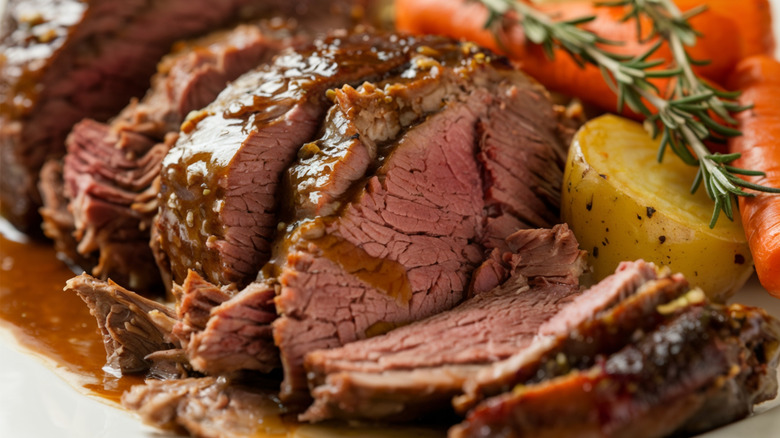A roast beef on rye sandwich is a classic choice at a deli, and for good reason. The meat is juicy, filling, and, ideally, a vibrant red color. But what if the roast beef looks a little lackluster? If it is dull, brown, or even grayish, it may be best to pass.
When roast beef is first processed, the color is a burgundy, almost purple hue. If it is vacuum sealed at this stage, it will retain this color and is perfectly good to eat. Once the meat is exposed to air, the myoglobin proteins in the beef react with oxygen, causing oxymyoglobin, which results in a bright red color. This is the state that consumers typically see and buy roast beef at, and the meat is at its most flavorful at this point after having rested. Remember that red juice isn’t blood; it’s just a stage of oxidation.
While oxymyoglobin is an oxygenated protein, the myoglobin will eventually lose this oxygen, transforming into metmyoglobin. At this point, roast beef starts to brown, and this is where eating it can get murky. It’s important to note that this oxidation process happens within a couple of hours to a few days after the meat has been exposed to air, so the color alone might not be enough to rely on. When roast beef starts to spoil, it develops a pungent smell and is tacky to the touch. If any of these other factors appear, skip that slice.
How to shop at a deli
“Deli meat” is the catch-all term given to any meat that has been sliced after being cured or cooked, and is usually served cold. There is a huge variety of deli meats, ranging from beef to pork to poultry, and sometimes a combination. With so many items on offer, it can be overwhelming to know what to buy and what not to buy at a deli.
Poultry colors can range from white and beige or tan. If there are some pink spots, it’s worth enquiring about, but it usually just indicates that the bird lacked fat in that particular area, so certain chemical changes skipped that section. Pork products, like salami, can pose more of a challenge as color is so variable. Aside from color inspections, it is necessary to check for mold growth. White mold is usually not unhealthy and is a natural reaction to the meat’s casing, but any other color of mold (black, blue, yellow, or green) indicates spoilage. This is sometimes mistaken for iridescent, rainbow spots on meat, which is perfectly safe to eat. Lastly, beef products that display yellow or gray spots should be skipped. Brown is less decisive, but make sure that freshly-sliced beef has not been sitting out for more than a few hours, especially at room temperature.






